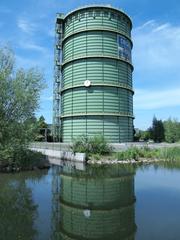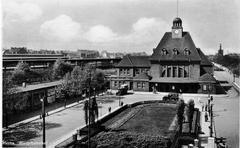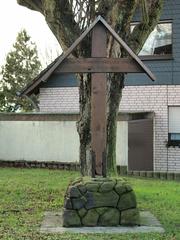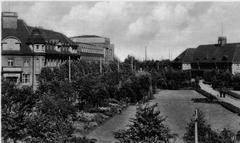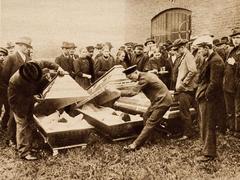Herne Power Plant: Visiting Hours, Tickets, and Guide to Herne Historical Sites
Date: 04/07/2025
Introduction
Nestled in the heart of Germany’s Ruhrgebiet, the Herne Power Plant stands as a testament to the region’s storied industrial past and its innovative future. Originally commissioned in 1962 as a coal-fired facility, Herne has continuously evolved, embracing state-of-the-art technologies such as combined-cycle gas turbines and advanced heat and power systems. Today, the plant exemplifies Germany’s commitment to energy transition and environmental sustainability, supplying electricity and district heating to the Rhine-Ruhr metropolitan region. This guide offers a detailed overview of the Herne Power Plant’s history, technological development, and practical visitor information, including hours, ticketing, tours, and nearby attractions (STEAG Press Release; Renewable Energy World; Wikipedia).
Table of Contents
- Introduction
- Historical Overview and Technological Evolution
- Visiting the Herne Power Plant
- Cultural Significance and Events
- FAQs
- Visuals and Media
- Related Resources
- Key Milestones in the Plant’s Evolution
- Practical Visitor Guide
- The Ruhrgebiet and Herne’s Industrial Heritage
- Summary and Final Tips
- References
Historical Overview and Technological Evolution
From Coal to Combined Cycle: A Timeline
1962–1980s:
The Herne Power Plant was initially constructed to serve the Ruhr’s burgeoning industrial sector. Operating as a coal-fired facility with up to 950 MW capacity, it became a regional energy linchpin and a symbol of the Ruhr’s economic might (Wikipedia).
1980s–2000s:
Expansion brought the Herne 4 unit, whose 300-meter chimney became a city landmark. This phase saw the plant transition into a combined heat and power (CHP) facility, enhancing efficiency by supplying both electricity and district heating (STEAG Press Release).
2018–Present:
Responding to Germany’s Energiewende, Herne shifted toward cleaner energy. Construction of the Herne 6 combined-cycle gas turbine (CCGT) facility began in 2018 in partnership with Siemens, culminating in a plant capable of producing 625 MW of electricity and 400 MW of district heating with drastically reduced emissions (Power Technology; Global Energy Monitor).
2021:
Herne 4’s coal-fired unit was decommissioned and converted to a gas-fired boiler for backup district heating (STEAG Press Release).
Technological Advancements:
Herne 6 features Siemens H-class turbines, hydrogen-ready infrastructure, and advanced integration with a 23-kilometer gas pipeline and the Ruhr district heating grid (Iqony Energy).
Visiting the Herne Power Plant
Visiting Hours and Ticketing
- Guided Tours: Offered by appointment only; advance booking (at least two weeks ahead) is strongly recommended.
- Tour Availability: April–October, Monday to Saturday, typically between 10:00 AM and 4:00 PM. Availability may vary due to operational or safety requirements.
- Ticket Prices: Adults €8–10; students, seniors €5; discounts for groups. Some educational tours are free for school groups.
- Booking: Reserve via STEAG’s visitor portal, Stadtmarketing Herne, or at the local visitor center.
What to Expect on a Tour
Tours are designed to immerse visitors in the plant’s operational and historical context. Highlights include:
- Walkthroughs of control rooms and turbine halls
- Explanations of combined cycle and CHP technology
- Insights into district heating and environmental measures
- Interactive displays and multimedia presentations
Note: Photography is generally allowed but may be restricted in sensitive areas.
Accessibility
The plant is accessible to visitors with mobility impairments; however, some areas may have limited accessibility due to industrial infrastructure. Please notify the visitor center of any special requirements when booking.
Safety
All visitors must adhere to safety protocols, including use of provided helmets and ear protection. Minimum age requirements may apply; tours are generally suitable for children aged 10 and above.
Cultural Significance and Events
The Herne Power Plant is a key part of the Ruhrgebiet’s industrial culture, reflecting both the challenges and achievements of Germany’s energy evolution. The site occasionally hosts:
- Educational programs and workshops
- Special events like open days and photography tours
- Community events during regional festivals
For event updates, consult the STEAG website or Herne Tourism Office.
Frequently Asked Questions (FAQs)
Q: Can the public tour the Herne Power Plant?
A: Yes, by advance appointment only.
Q: How do I book tickets?
A: Via the official STEAG portal, Stadtmarketing Herne, or by contacting the visitor center.
Q: Is the plant accessible for people with disabilities?
A: Yes, but please inform the visitor center in advance to ensure proper accommodations.
Q: Are tours suitable for children?
A: Tours are family-friendly, but recommended for ages 10 and up.
Q: Can I take photos inside the plant?
A: Generally yes, but some areas may have restrictions.
Q: Are there COVID-19 measures in place?
A: Yes, local health regulations apply.
Visuals and Media
- Virtual tours, photo galleries, and videos are available on the STEAG website.
- Images include the Siemens SGT5-8000H turbine, district heating network, and guided tour groups (with descriptive alt text for accessibility).
Related Resources
- STEAG Visitor Information
- Herne Tourism Office
- Renewable Energy World: Herne 6 Overview
- National Geographic: Ruhr Industrial Heritage
- ERIH: German Mining Museum
Key Milestones in Herne Power Plant’s Evolution
- 1962: Commissioning of original coal-fired plant
- 1980s: Expansion with Herne 4 and iconic chimney
- 1989: Herne 4 CHP unit operational
- 2018: Start of Herne 6 CCGT construction
- 2021: Herne 4 decommissioned and converted to gas-fired backup
- 2022: Herne 6 commences commercial operation
Practical Visitor Guide
Getting to Herne Power Plant
- By Train: Herne central station is 10 minutes by taxi; regional trains connect to Dortmund and Essen.
- By Bus: Local lines stop near the plant—check current schedules.
- By Car: On-site parking is available.
Nearby Attractions
- Ruhr Museum: Industrial heritage exhibits
- LWL Industrial Museum: Machinery and interactive displays
- Schloss Strünkede: Historic castle and gardens
- Flottmann Hallen: Art and industrial sculpture spaces
- Cranger Kirmes: Germany’s largest fair, held in August (Places and Things To Do)
The Ruhrgebiet and Herne’s Industrial Heritage
Herne is part of the Ruhrgebiet, once Europe’s industrial powerhouse. Its dense landscape of mines, steelworks, and power plants shaped both the economy and culture of the region (National Geographic). Today, many of these sites have been transformed into museums and cultural venues, forming the backbone of the European Route of Industrial Heritage (ERIH) (ERIH).
Industrial Tourism:
Guided tours and educational programs at Herne and other sites provide insights into the Ruhr’s transformation from a center of heavy industry to one of innovation and sustainability.
Cultural Life:
The Cranger Kirmes festival and Herne’s lively culinary and arts scene reflect the enduring community spirit forged in the industrial era.
Summary and Final Tips for Visiting Herne Power Plant
The Herne Power Plant encapsulates a compelling story of transformation: from its roots as a coal-fired giant to its current role as a symbol of sustainable energy and innovation. Guided tours allow visitors to explore this evolution firsthand, offering unique perspectives on technology, history, and environmental responsibility. Pair your visit with other industrial heritage sites in the Ruhr for a full appreciation of the region’s legacy and future.
- Book tours well in advance
- Check accessibility and safety guidelines
- Combine with visits to local museums and events
- Stay informed about special programming via official channels
Herne Power Plant is not just an energy facility—it is a living emblem of Germany’s journey toward a greener future (STEAG Press Release; Stadtmarketing Herne; Renewable Energy World).
References and Useful Links
- STEAG Power Plant Visitor Information
- STEAG GmbH Official Visitor Page
- Renewable Energy World: Siemens Builds Combined Cycle Power Plant in Herne
- Wikipedia: Herne Power Plant
- National Geographic: Ruhr Industrial Heritage
- ERIH: German Mining Museum
- Places and Things To Do in Herne
